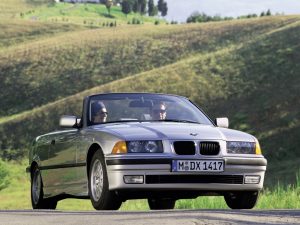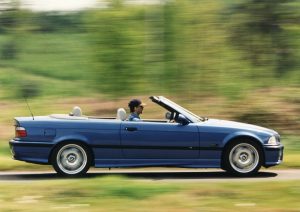Recalls: BMW E36 3-Series convertible
Overview
Manufacturers, or importers, issue recalls for defects or faults which have the potential to cause injury. Generally, manufacturers will inform the original buyers if their vehicle is subject to a recall and of the steps required to remedy the defect or fault. Please note that the recalls below (if any) are for Australian-delivered vehicles only. Furthermore, the number of recalls should not be taken as an indication of a model’s reliability or its safety more generally.
Recalls:
- In July 1996, a recall was issued for certain BMW E36 3-Series vehicles due to a fault in the brake light switch which could result in the brake lights not cancelling after the vehicle has stopped braking, or not illuminating at all (PRA 1996/2870).
- In November 1998, a recall was issued for certain BMW E36 3-Series vehicles due to a defective radiator cap (PRA 1998/3726).
Problems and faults: BMW E36 3-Series convertible
Overview
This section identifies potential problems, causes and fixes based on the experiences of owners and repairers, online sources and technical service bulletins. This information is provided solely for reference purposes and AustralianCar.Reviews recommends that only properly qualified persons carry out repairs or modifications. Furthermore, the number of items below should not be taken as an indicator of a model’s reliability or the frequency with which they may occur.
To report a problem or fault to the AustralianCar.Reviews team, please use the Contact Us form. Note that AustralianCar.Reviews does not offer advice on automotive problems or disputes; such enquiries will not receive a reply. For vehicles purchased from dealers after 1 January 2011, please see our Australian Consumer Law fact sheet.
BMW E36 3-Series: rear floor cracks at sub-frame mount area
For the BMW E36 3-Series, the rear floor was susceptible to cracks in the area of the rear sub-frame mounts. Due to bending of the rear chassis and movement that was allowed by rubber bushings, the chassis mounting points for the sub-frame would flex, weaken and, eventually, tear from the chassis.
The original, standard mounts were a flat plate that had an internally threaded tube and were welded to the chassis. The flex of the rear sub-frame caused this threaded tube and mounting bolt to act as a lever arm where the plate was welded to the chassis – this weakened the surrounding sheet metal. Due to the torque applied by the drivetrain on the sub-frame, the right side front mount would fail first, followed by the left side rear mount.
For the E36 M3, BMW developed a chassis reinforcement kit – which consisted of four reinforcement plates – that were welded to the underside of the chassis and significantly stiffened the mounts (it is understood, however, that some early 1994 BMW E36 M3 vehicles may not have been fitted with these reinforcement plates). To prevent cracks, these reinforcement plates can be fitted to other E36 3-Series vehicles.
To weld the reinforcement plates, the rear suspension, rear sub-frame, exhaust and driveshaft had to be removed. It is was also recommended that the back seat, rear interior, boot interior and fuel tank were also removed and all fuel lines were capped to prevent a fire hazard.
E36 328i: M52 VANOS failure
Forthe M52 and M52TU engines, the VANOS units may fail due to deterioration of the VANOS piston seal O-ring which is made from Buna (a material with limited temperature resistance). Over time, the O-ring hardens and shrinks, causing it to lose its functional characteristics – this can cause symptoms such as a loss of power below 3000 rpm, surging around 3000 rpm, a louder idle and rough running.
The piston O-ring lies under and provides support to a Teflon piston seal ring. Replacing the O-ring requires the Teflon seal to be removed for access. Since the Teflon seal cannot be removed from the piston seal groove without damaging it, the Teflon and O-ring seals must be replaced simultaneously. For greater longevity, the Buna O-ring can be replaced with an O-ring made from Viton.
For the M52TU engine, the VANOS units had two piston seals with O-rings, while each piston had two O-ring sizes to provide hydraulic sealing in two VANOS cylinders of different sizes and an additional, smaller O-ring that was used to seal off a piston bearing. It is understood that the O-ring for this cap was also made from Buna and deteriorated in the same manner as the piston seal O-rings.
E36 325i: M50B25 engine overheating, ticking and timing chains
- Overheating may be caused by a defective water pump or thermostat –
- For the water pump, the plastic impellor can become brittle and crack. To prevent this, a water pump with a metal impellor can be installed. For later pumps, BMW used a higher-grade plastic; and,
- The plastic thermostat housing can become brittle and crack. aluminium thermostat housings are available as a replacement.
- The hydraulic lifters can wear out, producing noisy and inefficient valvetrain operation. This can be detected by a ‘ticking’ noise from the engine.
- On high mileage engines, the timing chain can stretch, causing poor running and a ‘clagging’ noise. Replacement of the timing chain tensioner may fix this issue and alleviate the noise.
Problems and faults: BMW E36 3-Series convertible
- The automatic transmission may be slow to engage gears after sitting overnight because the fluid drains out of the torque converter.
- The hazard lights may start flashing by themselves and the turn signals may flash at twice the normal speed due to condensation shorting out the circuit board.
- If the central locking system unlocks itself after being locked or locks itself after being unlocked, the actuators could be defective; alternatively, the boot lock may need to be adjusted.
- For models with 2.5- and 2.8-litre engines, the variable valve timing system (VANOS) may jam, causing a rough idle and the ‘check engine’ light to illuminate.
- The starter motor may fail because it keeps running after the engine starts and eventually burns out – this can occur due to a sticking ignition switch. To fix, the whole lock and switch must be replaced.




